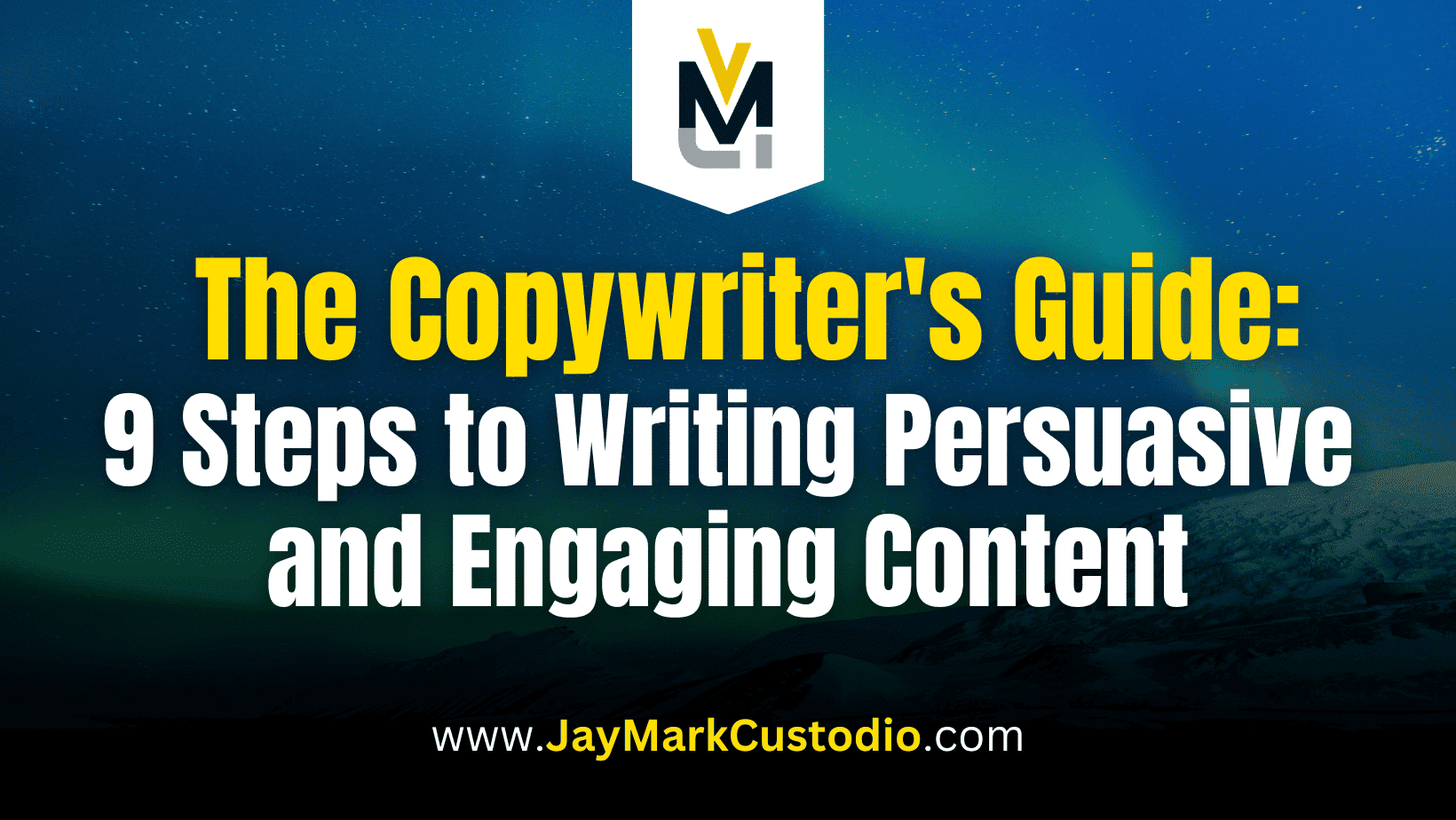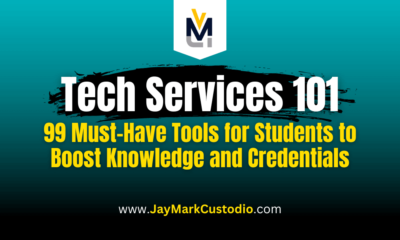Business
The Copywriter’s Guide: 9 Steps to Writing Persuasive and Engaging Content

Writing persuasive and engaging content is a crucial skill for any copywriter. Whether you’re creating ad copy, email newsletters, or website content, capturing your audience’s attention and keeping them engaged is essential.
Table of Contents
This guide will take you through the nine critical steps to writing compelling copy that resonates with your audience and inspires action.
With these tips, you can craft a clear copy that drives results and helps you achieve your goals.
So, let’s dive in!
1. Identify your target audience
Identify your target audience: The first step to becoming an effective copywriter is to identify your target audience. Determine who your ideal customer is, what their needs and pain points are, and what motivates them to take action.
Here is a bullet point guide on how to identify your target market for copywriting:
- Start with demographics: Identify the age, gender, income level, education, and other demographic characteristics of your ideal customer.
- Determine your customer’s needs: Understand the problems your customer is trying to solve, their pain points, and the benefits they seek.
- Look at your competition: Research your competition and see who they are targeting. Identify any gaps in the market where you could fill a need.
- Analyze your existing customer base: If you have an existing customer base, look at the demographics and characteristics of your best customers to identify patterns and commonalities.
- Conduct surveys and focus groups: Conduct surveys or focus groups to gather information directly from your target audience. Ask them about their preferences, behaviours, and what motivates them to take action.
- Use social media: Use social media to monitor conversations related to your product or service. Identify what people say about your industry, competition, and brand.
- Analyze website traffic: Use tools like Google Analytics to analyze your website traffic and identify patterns. Look at which pages are most popular, which keywords people use to find your site, and how long they stay on your site.
- Consider your product or service: Consider the benefits and features of your product or service and who would be most likely to use it.
- Develop buyer personas: Once you have gathered all this information, develop buyer personas – fictional characters representing your ideal customer. Use these personas to guide your copywriting and ensure your message resonates with your target audience.
2. Conduct research
Once you have identified your target audience, research to gather information about their interests, preferences, and behaviours. Use this information to tailor your copy to their specific needs and interests.
Here is a bullet point guide on how to conduct research for copywriting:
- Identify your research goals: Before conducting research, identify your goals. What information do you need to gather, and what questions do you need to answer?
- Determine your research methods: Determine how you will gather information. This could include surveys, focus groups, interviews, online or secondary research.
- Develop a research plan: Develop a research plan that outlines the research methods you will use, the timeline for conducting research, and the resources you will need.
- Identify your target audience: Identify your target audience and determine what information you need to gather about them. This could include demographic information, psychographic information, and behavioural information.
- Conduct primary research: If you are conducting primary research, such as surveys or focus groups, develop a questionnaire or discussion guide to help you gather the necessary information.
- Analyze your findings: Once you have gathered your research data, analyze your findings. Look for patterns, trends, and themes to help you better understand your target audience and develop more effective copy.
- Conduct secondary research: Conduct secondary research, such as online research or reviewing industry reports, to gather additional information about your target audience or industry.
- Stay up-to-date: Stay up-to-date with industry trends and developments by subscribing to industry publications, attending conferences, or joining professional organizations.
- Use your research to guide your copywriting: Use the insights you gather from your research to navigate your copywriting. Tailor your message to your target audience’s needs, interests, and behaviours to create more compelling copy.
3. Develop a Unique Selling Proposition (USP)
A unique selling proposition (USP) is a statement that sets your product or service apart from the competition. Develop a USP that communicates the benefits of your product or service to your target audience.
Here is a bullet point guide on how to develop a unique selling proposition for copywriting:
- Identify your target audience: To develop a unique selling proposition (USP), you must start by identifying your target audience. Determine who your ideal customer is, what their needs and pain points are, and what motivates them to take action.
- Understand your competition: Research your competition and identify their customers’ offers. Look for gaps in the market where you could fill a need your competition needs to address.
- Determine your unique selling point: Determine what makes your product or service unique and why your target audience should choose you over your competition. This could be a special feature, a different pricing model, or a better customer experience.
- Focus on benefits, not features: When developing your USP, focus on the benefits of your product or service, not just the parts. Identify how your product or service solves your target audience’s problems or fulfils their needs.
- Keep it simple and memorable: Your USP should be simple and unique, something your target audience can easily understand and recall. Use clear and concise language and avoid using technical terms or jargon.
- Test your USP: Test your USP with your target audience to see if it resonates with them. Get feedback and adjust your USP as needed.
- Use your USP in your copywriting: Once you have developed your USP, use it in your copywriting. Incorporate it into your headlines, taglines, and other marketing materials to create a consistent message that speaks directly to your target audience.
4. Write attention-grabbing headlines
Your headlines should capture your reader’s attention and draw them in. Use powerful words, emotional triggers, and curiosity to make your headlines more compelling.
Here is a bullet point guide on how to write attention-grabbing headlines for copywriting:
- Understand your target audience: To write attention-grabbing headlines, you must understand your target audience. Determine their needs and pain points and what motivates them to act.
- Use emotion: Use emotion in your headlines to create a connection with your target audience. Use powerful words that evoke strong emotions, such as “amazing,” “shocking,” or “heartbreaking.”
- Use numbers in your headlines to make them more specific and attention-grabbing. For example, “7 Surprising Ways to Save Money” is more compelling than “Ways to Save Money.”
- Use curiosity to pique your target audience’s interest and encourage them to read on. Use phrases such as “the secret to,” “what you don’t know about,” or “the truth behind.”
- Keep it short: Keep your headlines short and to the point. Use no more than 10-12 words to ensure your headline is easy to read and memorable.
- Test your headlines: Test different headlines to see which ones are most effective. Use A/B testing to compare headlines and see which generate the most clicks or engagement.
- Avoid clickbait: While writing attention-grabbing headlines is essential, avoid using clickbait tactics that are misleading or dishonest. Your headlines should accurately reflect the content of your copy and provide value to your target audience.
- Use keywords in your headlines to improve your search engine optimization (SEO) and make it easier for your target audience to find your content.
- Use subheadings to break up your copy and make it more scannable. Use subheadings to highlight the main benefits or points of your content.
5. Use persuasive language
Effective copywriting requires using compelling language. Use words and phrases that create a sense of urgency or scarcity, such as “limited time offer” or “while supplies last.” Use social proof, such as testimonials or case studies, to build trust and credibility with your audience.
Here is a bullet point guide on how to use persuasive language for copywriting:
- Understand your target audience: To use persuasive language, you must understand your target audience. Determine what motivates them to take action and what their pain points are.
- Use emotional triggers: Use emotional triggers in your copy to create a connection with your target audience. Use words and phrases that evoke strong emotions, such as “fear,” “joy,” or “excitement.”
- Use power words in your copy to make it more compelling. Power words are words that have a strong emotional impact, such as “amazing,” “proven,” or “guaranteed.”
- Use social proof: Use social proof, such as testimonials or case studies, to build trust and credibility with your target audience. Show how your product or service has helped others and how it can help them, too.
- Create a sense of urgency: Create a sense of urgency in your copy to encourage your target audience to take action. Use phrases such as “limited time offer,” “act now,” or “while supplies last.”
- Use scarcity: Use scarcity in your copy to create a sense of exclusivity and importance. Use phrases such as “limited availability,” “exclusive offer,” or “rare opportunity.”
- Address objections: Address objections in your copy to overcome any hesitations your target audience may have. Show how your product or service can solve their problems or fulfil their needs.
- Use active voice: Use active voice in your copy to make it more engaging and persuasive. Use phrases like “you can” or “you will” to make your copy more personal.
- Use repetition in your copy to reinforce your message and make it more memorable. Repeat key benefits or phrases throughout your document to create a consistent message.
6. Use storytelling techniques
Storytelling is a powerful tool for engaging your audience and making your message memorable. Use anecdotes, case studies, and examples to illustrate your points and connect with your audience on an emotional level.
Here is a bullet point guide on how to use storytelling techniques for copywriting:
- Identify your story: To use storytelling techniques, you must identify your story. Determine what level you want to tell and how it relates to your product or service.
- Create a narrative arc for your story. This includes an introduction, rising action, climax, falling action, and conclusion.
- Use sensory details: Use sensory details to make your story more vivid and engaging. Use descriptive language that appeals to the senses, such as sight, sound, touch, taste, and smell.
- Use dialogue: Use dialogue to bring your story to life. Use direct quotes from your characters or customers to make your story more authentic and relatable.
- Show, don’t tell: Show, don’t tell your story. Use descriptive language and examples to illustrate your points and make your story more engaging.
- Use anecdotes to make your story more personal and relatable. Use real-life stories of your customers or employees to illustrate your points.
- Use humour to make your story more memorable and engaging. Use a spirit that is appropriate for your audience and supports your story’s message.
- Use structure: Use structure to make your story more compelling. Use a clear beginning, middle, and end to make your account easier to follow and more memorable.
- Connect with your audience: Use your story to connect with your audience emotionally. Use your story to show how your product or service can solve their problems or fulfil their needs.
7. Keep it clear and concise
Effective copywriting requires using clear and concise language. Avoid using jargon or technical terms that your audience may not understand. Use short sentences and paragraphs to make your copy easy to read and understand.
Here is a bullet point guide on how to keep it clear and concise for copywriting:
- Know your message: To keep your copy clear and concise, you need to know your message. Determine what you want to communicate and focus on that message throughout your copy.
- Use short sentences: Use short sentences to make your copy easier to read and understand. Break up longer sentences into shorter ones to make your copy more scannable.
- Use simple language: Use simple language your target audience can easily understand. Avoid using technical terms or jargon that may be unfamiliar to your target audience.
- Avoid redundancy: Avoid using redundant phrases or repeating the same information multiple times. Make sure each sentence and paragraph adds value to your message.
- Use active voice: Use active voice to make your copy more engaging and easier to read. Use phrases such as “we will” or “you can” to make your copy more personal.
- Use bullet points and lists: Use bullet points and lists to break up your copy and make it more scannable. Use bullet points to highlight key benefits or features of your product or service.
- Use subheadings to organize your copy and make it easier to read. Use subheadings to highlight the main benefits or points of your copy.
- Edit and proofread: Before publishing your copy, edit and proofread it carefully. Check for spelling and grammar errors, and make sure your message is clear and concise. Get feedback from others to ensure your copy is compelling.
- Get to the point: Get to the point quickly and avoid using too many words to make your message. Keep your copy focused on your message and avoid adding unnecessary details or information.
8. Edit and proofread
Before publishing your copy, edit and proofread it carefully. Check for spelling and grammar errors, and make sure your message is clear and concise. Get feedback from others to ensure your copy is compelling.
Here is a bullet point guide on how to edit and proofread for copywriting:
- Take a break: Take a break from your copy and return to it later with fresh eyes. This will help you see your copy from a new perspective and identify any errors or areas for improvement.
- Check for clarity and flow: Read your copy out loud to check for clarity and flow. Ensure your message is straightforward and your copy flows smoothly from one sentence to the next.
- Check for grammar and spelling errors: Use a grammar and spelling checker to identify any errors in your copy. Double-check any words flagged as potential errors to ensure they are correct.
- Use active voice: Use active voice to make your copy more engaging and easier to read. Use phrases such as “we will” or “you can” to make your copy more personal.
- Check for consistency: Check for consistency in your copy. Ensure you use the same tone, style, and voice throughout your copy. Use a style guide to ensure consistency in your writing.
- Cut out unnecessary words: Cut out unnecessary words and phrases to make your copy more concise. Look for any terms or phrases that don’t add value to your message and remove them.
- Get feedback from others to ensure your copy is compelling. Ask someone else to read your copy and provide feedback on its clarity, flow, and effectiveness.
- Use formatting to make your copy more scannable and easy to read. Use headings, bullet points, and lists to break up your copy and make it more visually appealing.
- Read backwards: Read your copy backwards to check for spelling errors. This will help you identify any misspelled words your spellchecker may have missed.
9. Continuously improve
To become an effective copywriter, you must continuously improve your skills. Stay up-to-date with new trends and techniques, and evaluate the effectiveness of your copy to identify areas for improvement. Experiment with different approaches and methods to find what works best for your target audience.
Here is a bullet point guide on how to continuously improve for copywriting:
- Read widely to stay up-to-date with industry trends and best practices. Read books, blogs, and articles on copywriting, marketing, and related topics.
- Attend conferences and workshops: Attend meetings and seminars to learn from experts and connect with other professionals in the industry.
- Get feedback: Get feedback on your copy to identify areas for improvement. Ask others to read your copy and provide feedback on its clarity, effectiveness, and overall impact.
- Analyze your results: Analyze the results of your copy to see what works and what doesn’t. Use analytics tools to track the performance of your copy, such as click-through rates, conversion rates, and engagement rates.
- Experiment with different approaches: Experiment with different strategies and techniques to see what works best for your target audience. Test other headlines, calls-to-action, and copy lengths to see what generates the best results.
- Learn from your mistakes: Learn from your mistakes and use them as opportunities for growth. Identify what went wrong and how you can improve in the future.
- Stay up-to-date with technology: Technology and new tools that can help you improve your copywriting skills. Use tools like Grammarly, Hemingway, or Yoast to improve your writing and optimize your copy for search engines.
- Network with other professionals: Network with other professionals in the industry to learn from their experiences and insights. Join writing groups or attend industry events to connect with other copywriters and marketers.
- Take courses or certifications: Take courses or certifications to improve your copywriting skills and demonstrate your expertise to potential clients or employers. Look for courses or certifications in copywriting, marketing, or related topics.
Conclusion
In conclusion, writing persuasive and engaging content is vital for any copywriter. Following the nine critical steps outlined in this guide, you can identify your target audience, conduct research, and create a unique selling proposition that sets your product or service apart from the competition.
Remember to constantly tailor your message to your target audience’s needs, interests, and behaviours to create compelling copy that resonates with them and inspires action.
With these tips, you can craft clear, persuasive copy that drives results and helps you achieve your goals.
References
- Developing eCommerce Customer Personas for Personalized Marketing – GritGlobal | Make an Impact. https://gritglobal.io/blog/developing-ecommerce-customer-personas-for-personalized-marketing/
- How to Identify Your Target Market – MineBook. https://minebook.me/how-to-identify-your-target-market/
- Keyword Research for SEO: What It Is & How to Do It. https://www.cstreetmedia.com/seo/keyword-research-for-seo-what-it-is-how-to-do-it/
- 6 Sales Strategy for EdTech To Accelerate Sales Processes. https://www.responsify.com/sales-strategy-for-edtech/
- Harnessing Social Media to Cultivate Executive Thought Leadership -. https://smarklabs.com/blog/cultivate-executive-thought-leadership-on-social-media/
- What is omnichannel marketing? Benefits and Strategies. https://www.amuratech.com/blog/what-is-omnichannel-marketing
- Graphic Design | Reignland Creatives. https://reignlandcreatives.com/graphic-design/
- How To Create a Buyer Persona. https://www.andrewjacobs.net/post/how-to-create-a-buyer-persona
- Creating Quality Content that Aligns with Your E-A-T Goals – Passionate Marketers. https://passionatemarketers.com/digital/seo/creating-quality-content-that-aligns-with-your-e-a-t-goals/
- What is an Advertising Claim?. https://affstuff.com/glossary/advertising-claim/
- Marketing On Target | Blue Zenith Design + Strategy. https://bluezenith.com/2022/10/marketing-on-target/
- Developing a Unique Selling Proposition for Your Startup. https://www.iuemag.com/m23/su/developing-a-unique-selling-proposition-for-your-startup
- The Impact of Home Schooling on Children’s Social Development – Educacion Especial. https://educacion-especial.com/2023/03/12/the-impact-of-home-schooling-on-childrens-social-development/
- Unlocking The Power Of Long-tail Keywords: Expert Strategies. https://www.serpple.com/blog/unlocking-the-power-of-long-tail-keywords/
- 10-step guide to writing great commercial copy | AGUITTA. https://aguitta.com/2023/03/10-step-guide-to-writing-great-commercial-copy/
- HOW TO WRITE BETTER FACEBOOK AD COPY – ADVERTISING AGENCY | CPC NINJA. https://www.cpcninja.com/blog/how-to-write-better-facebook-ad-copy
- 7 Steps Lead Generation Strategy for Generating Business. https://commandshift.ca/7-steps-to-successful-lead-generation/
- Bagwell, Christopher M. “A Case Study of Practitioner Perceptions on the Online Transition of Student Support Services at a Mississippi Community College.” 2022, https://core.ac.uk/download/551575724.pdf.
- Cybersense – We build your future. https://www.gocybersense.com/post/5-tips-for-creating-engaging-content-for-your-website
- Create Engaging Content: Develop Content That Is Visually Appealing and | Krotov Studio. https://krotovstudio.com/blog/smm-blog/develop-content-that-is-visually-appealing-and-relevant-to-the-target-audience/
- My Name is Inigo Montoya: How to Introduce a Character in Your Novel. https://www.dabblewriter.com/articles/how-to-introduce-a-character-in-your-novel
- Introducing Similes And Metaphors To Paint A Picture – Scatty.com. https://scatty.com/introducing-similes-and-metaphors-to-paint-a-picture/
- Paragraph On Kerala: A Comprehensive Guide To The Land Of Coconuts And Backwaters – Transfer and Postings. https://transferandpostings.in/essays/paragraph-on-kerala/
- Trouble in Paradise – Common Travel Writing Mistakes. https://www.feedyes.com/travel/trouble-in-paradise-common-travel-writing-mistakes/
- 🔥 Edit my college essay. 10 Most Common College Essay Editing Mistakes. 2022-10-06. http://childhealthpolicy.vumc.org/nynybozo53687.html
- Novel Editing 101: A Comprehensive Guide to Perfecting Your Manuscript. https://bubblecow.com/blog/novel-editing
- How to Make PDF Clear: Tips and Tricks – PDF File Store. http://www.pdffilestore.com/how-to-make-pdf-clear/
- Saivian: 14 Ways to Create an Irresistible Facebook Ad. https://ericdaliusgiving.com/saivian-14-ways-to-create-an-irresistible-facebook-ad/





















